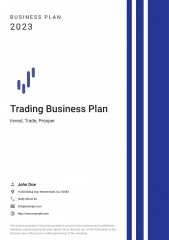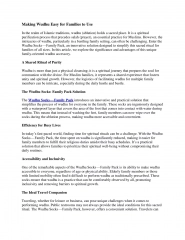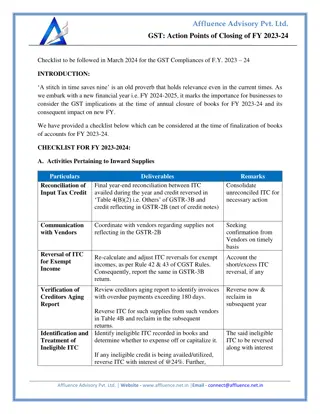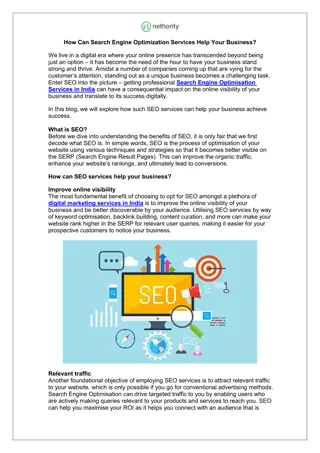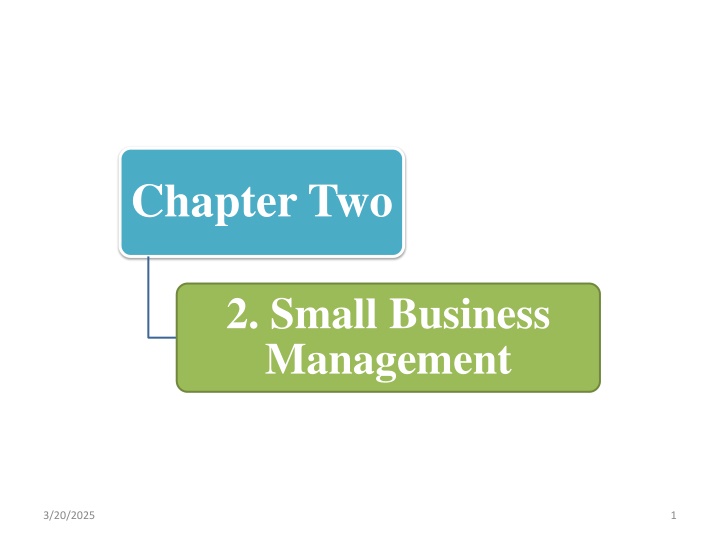
Insights into Small Business Management and Development
Explore the significance of Micro and Small Enterprises (MSE) in driving economic growth and creating employment opportunities in both urban and rural areas. Learn about the varied definitions and criteria used to categorize small businesses globally, with a focus on their role in sustainable development and poverty alleviation.
Download Presentation

Please find below an Image/Link to download the presentation.
The content on the website is provided AS IS for your information and personal use only. It may not be sold, licensed, or shared on other websites without obtaining consent from the author. If you encounter any issues during the download, it is possible that the publisher has removed the file from their server.
You are allowed to download the files provided on this website for personal or commercial use, subject to the condition that they are used lawfully. All files are the property of their respective owners.
The content on the website is provided AS IS for your information and personal use only. It may not be sold, licensed, or shared on other websites without obtaining consent from the author.
E N D
Presentation Transcript
Chapter Two .. 2. Small Business Management . 3/20/2025 1
2.1 Introduction Micro and Small Enterprises (MSE) is one of the institutions given recognition in the country's industry development plan. MSE is the fact that it serves as vehicles for employment opportunities both at urban center and rural areas reinforcing the economic development. MSE serves as sources for sustainable job opportunities not only for developing countries but also for developed countries. 3/20/2025 2
Contd These firms can be operated by limited resources, with fewer requirements machinery and modern technology. They can be established easily in urban, semi urban and rural areas where the infrastructure is underdeveloped with the objective of using local raw materials and skills. In any country they are acting as engine of growth through poverty and unemployment reductions. of sophisticated 3/20/2025 3
2.2 Definition and Importance 2.2.1 Definition of Small Businesses Due to lack of uniform definition of MSE across the globe, most countries use and implement based on legal meaning of the sector. MSE definition is generally consisted of three basic criteria. These are: 1. Full timer employed manpower /head count staff/. 2. Total asset, net asset and paid capital 3. Annual turnover and they use these criteria independently or in combination. 3/20/2025 4
In general the following points indicate experience of other countries. All countries encompass the micro, small and medium enterprises definition and support framework. The definition of the sector is viewed from the countries economic status and level of growth. In most countries definition of the sector is implemented uniformly and it has legal entity. 3/20/2025 5
Contd Manpower, total asset, net asset, paid capital and annual turnover serve as criteria independently or jointly. In some countries like China, USA, South Africa, MSE are divided in to manufacturing, construction, transport, wholesale and retail, and service sectors based on the type of industry. As to EU, most countries use uniform definition of MSE for all sectors 3/20/2025 6
The improved definition of MSE from Ethiopian Context In our country two different definitions of MSE were used so far i.e. the 1998 definition of MSE development strategy, and definition given by CSA. Improved definition for the sector was given based on the gathered experience, by identifying the gaps of the existing definition of MSE, including the size of employee and by taking total asset as criteria and by dividing it in to industry and service sector Considering the inflation and fluctuation/irregularity of currency. 3/20/2025 7
Contd Under micro enterprise level, industry sub- sectors operating with 5 people including the owner and/or their total asset is not exceeding Birr 100,000 (one hundred thousand). Under micro enterprise level, service sub- sectors operating with 5 persons including the owner of the enterprise and/or the values of total asset is not exceeding Birr 50,000(fifty thousand). 3/20/2025 8
Contd Under small enterprise level, Industrial sub- sectors operating with 6-30 persons and/or with a paid up capital of total asset Birr 100,000(one hundred thousand) and not exceeding Birr 1.5 million. Under small enterprises level, Service sub-sectors operating with 6-30 persons or/and total asset, or a paid up capital is with Birr 50,001 and not exceeding Birr 500,000 are defined officially and used in Ethiopia 3/20/2025 9
Main sectors and sub-sectors that focus area 1. Manufacturing sector Textile Leather Food Beverage Metal works Wood works Agro-processing 2. Construction Sub-contracting Building materials Traditional mining Cobble stone Infrastructure sub contract Prestigious goods 3/20/2025 10
Contd 4. service Transport service Caf and Restaurants Store service Tourism service Canning/packing Management service Municipality service Product design Maintenance etc. 3. Trade Whole sale Retailer Raw materials supply 3/20/2025 11
5. Urban Agriculture Modern livestock raring Bee production Poultry Modern forest development Vegetables and fruits Modern irrigation Animal food processing 3/20/2025 12
2.2.2 Importance( Special Contributions) of Small Businesses Although small business pose a number of challenges to the entrepreneur and have certain limitations, countries economy cannot do without them. This is because small businesses have special features that make them superior over large ones in certain aspects of business activities. 3/20/2025 13
Example of MSE importance Providing Job Opportunities Introducing Innovation Stimulating Economic Competition Aiding big business Supply function: Most small businesses act as suppliers, and sub- contractor for large firms. The distribution function: Few large manufacturers of in expensive consumer products find it desirable to own wholesale and retail outlets. Producing Goods and Services 3/20/2025 14
2.3 Characteristics of Small Scale Business Following are the characteristics of small scale business: High Labor Intensity Less Capital Intensive Use of Local Skills and Knowledge Flexibility Entrepreneurial Spirit Use of Indigenous Raw Materials Localized Operation Lesser Gestation Period - earn after a short period of time Workplace Culture No work specialization 3/20/2025 15
2.4 Objectives of Small Businesses A. Employment generation B. Equitable distribution of income C. Mobilization of resources and entrepreneurial skill D. Regional dispersal of industries E. Provides opportunities for development of technology F. Promotes exports G. Supports the growth of large industries 3/20/2025 16
2.5 Small Business Failure Factors MSEs failure attributing by many factors. These are: A. External factors B. Personal (internal) factors A. External factors Business cycles Fluctuating Interest rate Interrupted supplies Labor market Inflation Government regulations Unstable financial markets 3/20/2025 17
B. Personal (internal) factors Inexperience Arrogance Mismanagement Over investment on fixed assets Poor financial and inventory control Poor business philosophy Lack of planning 3/20/2025 18
2.6 Merits and Demerits of Small Businesses Advantages of owning a small business: i. Independency ii. Financial Opportunity iii. Job Security iv. Community Service v. To Practice Challenge 3/20/2025 19
Disadvantages of owning a small business: Competition Sales Fluctuation Increased Responsibilities Risk of Failure Employee relations 3/20/2025 20
3/20/2025 21
2.7 Problems of Ethiopian Small Businesses 1. Backward attitude 2. Rent seeking to provide institutional support 3. Unfamiliarity with efficient technology 4. Low managerial and technical skill 5. Limited access and limited amount of capital (Lack of seed money) 6. Limited market linkage and networks 7. Interrupted supply of key input 8. Lack of persistency 3/20/2025 22
Contd 8. Unreasonable investment of scarce finances on fixed assets 9. Perception of MSE themselves as reflection of poverty and backwardness 10. Waiting government for job and to solve all problems rather than being innovative 11. Failure in developing the culture of saving 12. Living with one's income/ dependency/ 3/20/2025 23
2.10 Steps in Setting Up Small Businesses An entrepreneur needs to take the following steps: 1. Search for Business Idea: The task of promotion begins with the search for a suitable business idea or opportunity. Sources of Business ideas Work experience Hobbies Deliberate search Observing the market Customers Government organizations Distribution channels, trade fair and exhibitions and mass medias 3/20/2025 24
2. Idea Processing/ Screening Business ideas/opportunities need to be screened and assessed for the viability. Criteria To Screen Business Ideas Include Marketability/demand Profitability of the idea if implemented Availability of raw materials Ease of implementation Financial feasibility Government support and incentives Personal goals and competencies of the entrepreneur 3/20/2025 25
3. Idea selection The feasibility report is analyzed to finally choose the most promising idea. 4. Assemble the necessary input requirements Assembles the necessary resources to launch the enterprise like: Choose partners/collaborators Collect the required finance Acquire land and buildings Plant and machinery Furniture and fixtures Patents Employees 3/20/2025 26
5. Establish the Enterprise The form of ownership is to be decided upon and the company formed and registered. Dealing with various government bodies and other institutions like: Financial institutions- for finance Sales tax, Income tax authorities- for respective registration Licensing authority- for obtaining industrial license 3/20/2025 27
Contd Municipal Authorities and Electricity- for requisite utilities. Directorate of Industries, Municipal Authorities etc. for land, factory and shed etc. Ordering machineries from suppliers Recruitment of staff Arranging supplies of materials Arranging for distribution of the product 3/20/2025 28
Thank you 3/20/2025 29






